HEMS Air Ambulance Landing Site Slide (BSAA H145 SE-JSS)
On 12 February 2022 Airbus Helicopters H145 air ambulance helicopter SE-JSS, based at Mariehamn Airport, Åland island, Finland was deployed to the nearby island of Fiskö after a person fell on ice. After landing at a confined site near the casualty, power was reduced to idle, the helicopter slid backwards and struck adjacent obstacles.

Babcock Scandinavia Air Ambulance Airbus H145 SE-JSS (Credit: Operator via SIAF)
The Safety Investigation Authority Finland (SIAF) issued their safety investigation report on 28 January 2024.
The Accident Flight
A 112 emergency call was received at 15:33.
Two roads with almost identical names are located in the municipality of Brändö, which caused confusion at first.
At 15:50 it was decided to task the helicopter to attend.
The helicopter had three occupants, pilot (1,725 total hours, 1,330 on type), Technical Crew Member (TCM) and nurse. Babcock Scandinavian Air Ambulance had provided ambulance helicopter services in Åland under a contract with Åland Health Care District from 2019 (but Babcock has since sold this business to Avincis).
Shortly after becoming airborne the helicopter was passed coordinates for helipad on Korsö island, approximately 15 min flying time away. Only when halfway into the flight, were the helicopter crew informed that the casualty was on Fiskö and they were asked to proceed direct to the accident site (about 5 km northwest of the helipad). SIAF say:
At 8 km from the accident site, the pilot descended to 500 ft (150 m) above ground level. During the approach, he reduced speed so he could identify the correct house among the buildings of the small community.
They had been told that “someone would be outside waving a white cloth to help in identification”.
The crew did not obtain visual contact with this person or the house during the first overflight, but during the second they spotted the house and agreed on the conduct of an off-airfield landing.
Even though buildings, trees and a power line were observed in the area, the vicinity of the intended landing site and the approach path were clear of obstructions that could have jeopardized the landing.

Babcock Scandinavia Air Ambulance Airbus H145 SE-JSS Landing Site at Fiskö (taken 13 Feb 2022). Orange Shading Indicates 11 m Diameter Rotor Disc. Red Shading a 17 m ‘Danger Zone’ (Credit: SIAF). The red arrow indicates slide direction. Prevailing wind was from the direction indicated by the thick blue arrow, variable between the thin blue arrows. The white arrow points to grid north.
SIAF only mention this ’17 m danger zone’ in the caption of image above and don’t elaborate on landing site size requirements otherwise. AMC1.SPA.HEMS.125(b)(4) (performance requirements for HEMS operations) states a 2 D site is required by day (which for a H145 is 27.3 m).
An approach was made…
After the pilot had brought the helicopter to hover, the {technical] crew member [TCM] opened the door and scanned the area below and to the left for any obstructions that would be a factor during landing. He notified the pilot of a bush to the left of the helicopter’s tail about 6 m away but paid no particular attention to the fact that the ground was partially covered with ice.
SIAF also comment on their being loose articles at the site. The pilot elected to land.
Even though landing was uneventful, and the helicopter appeared stable…the pilot felt it was slightly
tilted to the right. With the flight controls neutralized, the attitude indicator showed 2° to 3° right bank, well below the maximum permitted value of 8°. The pilot set the engines to idle.
The crew’s attention was diverted to a person approaching the helicopter who was signalled by hand to wait. However, seconds after the engines were set to idle…
…the helicopter began to slide tail first on the ice-covered driveway at increasing speed until, after approximately 20 m of travel, the main rotor struck a boat shed to the right of the helicopter. The impact rotated the helicopter towards the shed, and the right side of the fuselage hit the wall.

Babcock Scandinavia Air Ambulance Airbus H145 SE-JSS Accident Site Showing a Thin Layer of Ice (Credit: Operator via SIAF)
During the slide the pilot assessed their was insufficient time to spool up the engines and safely lift off. He also considered that rotor brake application would have have most likely “resulted in abrupt yaw or other uncontrollable motion”.
Because the helicopter was unstable and vibrating violently, the pilot was unable to shut down the engines by operating the switches in the lower center instrument panel and therefore elected to press the emergency shutdown switches located below the glareshield.

Babcock Scandinavia Air Ambulance Airbus H145 SE-JSS (Credit: via SIAF)
The pilot and TCM were uninjured but the nurse in the rear of the helicopter suffered a minor back injury. The original casualty and the nurse were transported to hospital by a Border Guard helicopter that landed c 250 m away on a relatively large field.

Alternative Landing Site at Fiskö Used by the Border Guard (Credit: SIAF)
The Safety Investigation
A SIAF-developed AcciMap was used to support the analysis:

The investigators note that the decision to request the helicopter land close to the casualty was based on the 112 caller’s information, “not on accurate technical data” and the assumption that ground conditions would be difficult to move the casualty. The open field about 250 m away, used by the Border Guard helicopter, “would have offered a better landing area”.
The crew found the yard confined yet meeting the published landing site criteria. Because the crew members focused on obstacles bordering the landing site and on loose objects during landing, they paid little attention to the fact that the terrain was covered with ice.
The challenging landing site distracted them from the hazards caused by the slippery, sloping surface. The technical crew member’s duties include checking the ground below, but apparently this was not done, or the crew member devoted most of his attention to edge obstacles.
The helicopter set down with the skis only partially on gravel. The company operating manual contains a comprehensive list of aspects that should be considered during landing site selection. These include slippery ground and sloping terrain.
SIAF say:
The slide was possibly induced by a slight motion of the helicopter to the left when the engines began to spool down.
The tubular metal skids offered little grip on wet, exceptionally slippery ice. The shape and smooth surface of skids enable the helicopter to slide over a slippery surface. This characteristic is useful on an autorotative landing and under some other circumstances. Slide stoppers are rarely fitted to skids, even for off-airfield operations in winter.
Also of note is that:
The investigation team vetted 31 occurrence reports filed in Babcock in 2016–2020. Six of them involved a snowy or slippery landing site. In one of the occurrences, the helicopter had slid over a distance of a few meters on landing, while in five events slippery ground or snow had caused difficulties during landing. The reports had been processed in accordance with the procedure laid down in the operator’s safety management system (SMS).
No further comment is made by SIAF (for example on any training / safety promotion activity based on this data).
SIAF Safety Recommendations & Actions
As well as three recommendations that relate to emergency service tasking, management & communication, SIA recommended that the EU Aviation Safety Agency (EASA) “informs helicopter operators of a need to fit slide stoppers on the landing skids for operations in winter and under slippery conditions” (Recommendation 2023-S2).
EASA noted that an optional slide prevention kit has been certified by Airbus and sensibly highlighted that…
…the current regulatory framework requires an air operator to ensure that its aircraft are in a proper configuration…for operations in each area and for each mode of operation.
Operators should also conduct applicable safety risk assessments in accordance with requirements laid .own in their management system…
After this occurrence Babcock “decided to fit slide stoppers to all skid-equipped helicopters during the fall of 2022”.
Safety Resources: Landing Site Recces: 5Ss, 5S + A or 6s
Many operators apply the 5s principles for site selection:
- Size
- Shape
- Surroundings
- Surface
- Slope
Others add consideration of the site vs the task (e.g. in relation to the casualty location):
- Accessibility or
- Suitability
UPDATE 4 Feb 2024: One reader has kindly highlighted this case of a DRF EC135P2 on 26 January 2014 were Surface & Slope also combined to create a slide:
Other Safety Resources
The European Safety Promotion Network Rotorcraft (ESPN-R) has a helicopter safety discussion group on LinkedIn. You may also find these Aerossurance articles of interest:
- After Landing this HEMS Helicopter Suddenly Started to Slide Towards it’s Hangar…
- Low Recce of HEMS Landing Site Skipped – Rotor Blade Strikes Cable Cutter at Small, Sloped Site
- US Air Ambulance Near Miss with Zip Wire and High ROD Impact at High Density Altitude
- Hanging on the Telephone… HEMS Wirestrike
- Beware Last Minute Changes in Plan
- Norwegian HEMS Landing Wirestrike
- HEMS Pilot Seizure While Rotor-Running
- BK117 Offshore Medevac CFIT & Survivability Issues
- Air Ambulance EC135 Loss of Control & Main Rotor / Engine Overspeeds
- Police Helicopter Unanticipated Yaw & Fatal Water Impact
- EC135 Air Ambulance CFIT when Pilot Distracted Correcting Tech Log Errors
- Managing Interruptions: HEMS Call-Out During Engine Rinse
- Distracted Dynamic Rollover
- Sécurité Civile EC145 SAR Wirestrike
- Dusk Duck: Birdstrike During Air Ambulance Flight
- HEMS AW109S Collided With Radio Mast During Night Flight
- Air Ambulance B407 Hospital Helipad Deck Edge Tail Strike During Shallow Approach
- Night Offshore Windfarm HEMS Winch Training CFIT (BK117C1 D-HDRJ)
- US Air Ambulance Helicopter Hospital Heliport Tail Strike
- Air Methods AS350B3 Air Ambulance Tucson Tail Strike
- NTSB on LA A109S Rooftop Hospital Helipad Landing Accident
- Helicopter Destroyed in Hover Taxi Accident
- Air Ambulance Helicopter Downed by Fencing FOD
- Ambulance / Air Ambulance Collision
- Multi-Tasking Managers & Deficient Operational Control: Low Viz AS350B3 Take-Off Accident
- A HEMS Helicopter Had a Lucky Escape During a NVIS Approach to its Home Base
- NVIS Autorotation Training Hard Landing: Changed Albedo
- Why a Collective Control Came Loose in a Pilot’s Hand…
- Man Hit By Aircraft During Arctic Nuclear Sub Exercise
- UPDATE 11 February 2024: Air Ambulance Night Wirestrike at Poorly Chosen Landing Site
See also:
- EHEST Leaflet HE 3 Helicopter Off Airfield Landing Sites Operations
- Guidance on “Welcoming Helicopters” at emergency sites.

Recent Comments